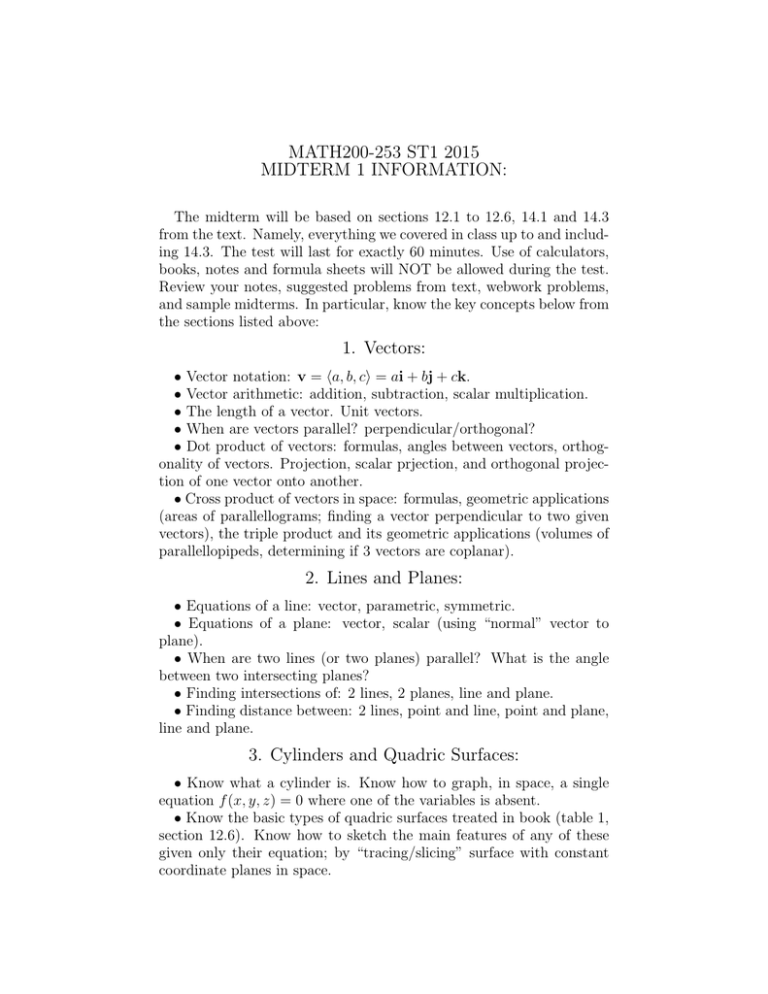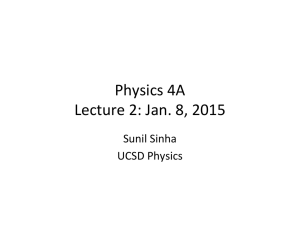MATH200-253 ST1 2015 MIDTERM 1 INFORMATION:
advertisement

MATH200-253 ST1 2015 MIDTERM 1 INFORMATION: The midterm will be based on sections 12.1 to 12.6, 14.1 and 14.3 from the text. Namely, everything we covered in class up to and including 14.3. The test will last for exactly 60 minutes. Use of calculators, books, notes and formula sheets will NOT be allowed during the test. Review your notes, suggested problems from text, webwork problems, and sample midterms. In particular, know the key concepts below from the sections listed above: 1. Vectors: • Vector notation: v = ha, b, ci = ai + bj + ck. • Vector arithmetic: addition, subtraction, scalar multiplication. • The length of a vector. Unit vectors. • When are vectors parallel? perpendicular/orthogonal? • Dot product of vectors: formulas, angles between vectors, orthogonality of vectors. Projection, scalar prjection, and orthogonal projection of one vector onto another. • Cross product of vectors in space: formulas, geometric applications (areas of parallellograms; finding a vector perpendicular to two given vectors), the triple product and its geometric applications (volumes of parallellopipeds, determining if 3 vectors are coplanar). 2. Lines and Planes: • Equations of a line: vector, parametric, symmetric. • Equations of a plane: vector, scalar (using “normal” vector to plane). • When are two lines (or two planes) parallel? What is the angle between two intersecting planes? • Finding intersections of: 2 lines, 2 planes, line and plane. • Finding distance between: 2 lines, point and line, point and plane, line and plane. 3. Cylinders and Quadric Surfaces: • Know what a cylinder is. Know how to graph, in space, a single equation f (x, y, z) = 0 where one of the variables is absent. • Know the basic types of quadric surfaces treated in book (table 1, section 12.6). Know how to sketch the main features of any of these given only their equation; by “tracing/slicing” surface with constant coordinate planes in space. • In particular know how to find the equation of a sphere given the center and the radius, and how to determine the center and the radius if you are given the equation. 4. Functions of two (or three) variables. • Domain and Range. • The graph in space of a function f (x, y). • Level curves of a function of two variables. Level surfaces of a function in three variables. • Partial derivatives: know how to calculate these. Know what the first partial derivatives represent in terms of rates of changes of the function. Know what higher order partial derivatives are, and know Clairaut’s theorem. Know what a partial differential equation is, in particular, know what it means for a function to solve a partial differential equation. NOTE: we have not covered §14.2 on limits and continuity in great detail, and you will not be tested on that section.



